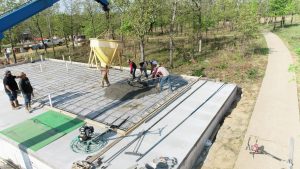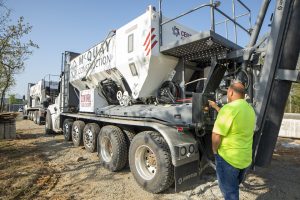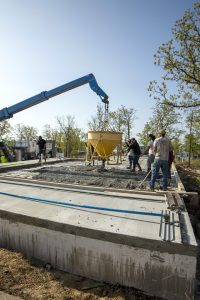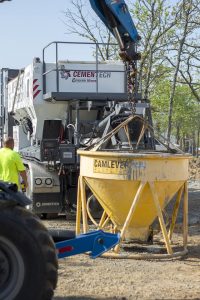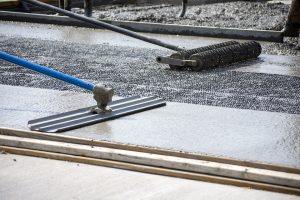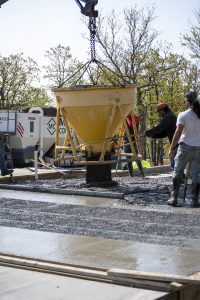ACCU-POUR™ Allows McQuay Construction To Control Their Business
Zach McQuay thought one volumetric concrete mixer would be enough for his growing construction business in southeast Oklahoma. Now he has three mixers and a fourth on the way, along with ACCU-POUR™ on every unit.
Tell us about your business as a whole.
I’m third generation in the cement business. My grandpa started it, [my] dad took over in 1977, and I took over in 2007-2008. I started with a backhoe and a five-gallon bucket of tools and a little trowel machine. And here we are 2021 and we’re producing our own concrete. We do all of our own dirt work and GPS. It’s really nice because we don’t have to wait on anybody and we’re 100 percent self-sufficient. It’s easier to keep a schedule, I don’t have to rely on anybody but myself.
How did you get into the volumetric mixer industry?
In the next 12 months, how many yards do you think you’ll be pouring with each of the trucks?
We’re sitting at about 7,000 yards right now. I think we’ve been in business right at six months and I’m shooting for the 14,000 to 20,000 yards this year for three trucks total.
I’ve heard that story a lot: “I was only going to get one, then I realized you can really start making money at two or three.”
Yes, but you know what happens is you get more and more customers and you don’t want to turn somebody away. And for us, like in this little community here, it’s not really possible to do continuous pours here like on the next job we’re going to. It’s a wide-open space, we stockpile material there, we can send two trucks and we’ll load them there, send a powder trailer there, we’ll get water from a fire hydrant. It’s very easy.
But in communities like this, you have to have multiple trucks. Cleanup is a huge issue here — we won’t clean up here at all. We’ll rinse our chute off then we’ll go back, we’ll clean up in our yard because they’ve had lots and lots of issues with the barrel companies dumping excess concrete. They’ll have waste everywhere you go — we don’t have waste. I mean the maximum we’ll have is maybe one wheelbarrow and we’ll try to auger that out into that hopper so we don’t leave anything. We’ll rinse the top of our chute off, we’ll go load, we’ll wash it off in our yard.
What has the community’s response been to these mixers?
So far it’s been really good, the barrel companies not so much. They don’t like us so much but the community support has been really good for us. We’ll stop to get fuel and they’re like, ‘Man, what is that?’ I go through and explain to them and they’re like, ‘Why haven’t those things been around’ And I say they’ve been around a long time, people only think you can get mud from a barrel truck. And once we tell them what we can do — and a huge thing for the consumer is you’re only paying for what you use.
Like here, we’re going to be around 25 yards, we should have roughly five yards left in the truck. Well, we’ll send that back, load more material on it and send it somewhere else. In a barrel truck, they’d have to pay for all that — that’s their savings. We’re the same or a little bit higher per yard but there’s zero waste and you only pay for what you use.
So it’s easy for me to sell you concrete when your concrete figure is 12 yards and I sell you 12.5 yards; with a barrel company, you’d have to order 15 yards. You’re going to want to pay for 12.5 yards, not 15 yards. It’s really an easy sell, they kind of sell themselves.
I think they’re a cool-looking truck, you get a lot of attention when you go somewhere because there’s not that many in our area. I think the closest is in Oklahoma City so there’s not that many in our area.
We’ve been super happy with them, no complaints whatsoever after we figured out what we were doing with the continuous pours. After that, it’s been great.
For me, I wanted the ease of use — it’s easy to train someone with your [Cemen Tech’s] system. I think in a few days they can run it and do a pretty good job with it. Some of the others look a lot more complicated for me. I can really make it easy, especially with ACCU-POUR™, I can send the job and I can do all the thinking for them. All they have to do is turn it on, start a pour, every information is there — it’s a red and a green button start-stop. I don’t think anybody else’s system is quite that easy but ours in just a few days of training, I can send them down the road. They don’t have to be a concrete guy.
What kind of work are you doing mostly?
Mostly we do commercial and industrial. When we first started with one truck, I was only going to take care of myself. Then on days I didn’t have anything going I was like ‘This is silly because I could be selling to the public’ Then we moved to the public [and] that’s when it grew from one truck to three trucks.
But it really helps us on our pours or continuous pours — we back two trucks into a pump. We produce 120 yards an hour which is more than what most barrel companies can consistently get there. When we’re not doing that, we pour to the public. We do just about everything from schools to homes; I think we have about 50 to 60 homes contracted to do. We signed another contract on another 350 homes that provide concrete on. [If] there’s anything that needs concrete, we’re now delivering it or producing it.
We’re doing a job at Broken Bow for the Corps of Engineers. They had never even seen a volumetric truck. The tester was really, really impressed with our breaks because we’re getting 90-percent at three to five days instead of 28 days. We could change our slump from three to five percent and that’s really easy to do. They wanted fiber in it and all these things that’s easy to do with these [volumetrics]. It’s not easy to do with a barrel truck. So, they were really, really impressed with it.
We’ve had a few learning curves with it but we’ve kind of got everything down now. I’d pour 1,000 yards tomorrow without any issues.
Let’s talk about ACCU-POUR™. You’ve had ACCU-POUR™ from the beginning — talk about how you’re using ACCU-POUR™ today, and what impact it has on your business.
ACCU-POUR™ for us really makes it easy because I can run this business from my iPad. I don’t actually have to be on the job, I can see where my trucks are in real-time, I can see how many yards they’re pouring. I can either send the job to the truck or they can start a local ticket. I can process it from my end which sends it to my office and they can get people a bill.
In my opinion, it ought to be a standard option. I don’t understand why anybody would want these trucks and not have ACCU-POUR™. Because if I had to leave today, I can look at my iPad and see if they’re still here and that helps me know what time to program in for the next job that we’re going to. Without that, I think it would be extremely hard to run my business as efficiently as we do.
It’s so easy to do billing, it’s easy to keep track of your materials, keep track of our powder usage. And then once a month, I go through there and see exactly how many yards we poured — how many we poured at 3,000 [PSI], 3,500 [PSI], the different rock sizes. It just does a lot of the work for you which I like. It’s very, very efficient; my office loves it. I just can’t imagine running these trucks without it.
You talked about using the reporting features on there to look at your powder usage. Can you expand on that a little more in terms of how you’re doing that and what you’re looking at?
You can go in there on the customers, and all of these tickets that I do, I can go in there and scan from my start date — I think we started in mid-August sometime last year. I can build a ticket from August to April and it’ll tell me exactly how much powder used, exactly how much sand I used, the rock, my admixes, even tells you exactly how much water you used. I can go in there for this customer and I can click on his profile and tell him exactly how many yards he’s poured since he started. So, if he has a question on anything, I can go back on my iPad — I don’t have to be at the truck — and look at any ticket. I can see who’s signed it, what time it was done, when the mixer started, what time it ended. I just can’t imagine trying to do it without that. It’s really made this system really, really simple to use and I think very efficient to use also because there’s just not that much that you can’t just check and see.
Like these guys were late last night. I can scan on the map, see on the satellite map where they’re at, how many yards, what time they stopped or what time they started. If I’m supposed to be at your place and you call and they’re not there, I pull up my iPad and see where they’re at. It’s really, really handy.
When you decided to put it on the first truck, talk about your decision-making process in terms of adding this option. What was going through your mind?
It was a money issue upfront to get that on, but once you see how it works, to me it wasn’t a money issue. It was more of a necessity that it needed to be on that truck. With ACCU-POUR™, it makes their job easier and it makes my job easier. I can process this ticket, I’ll send it to Miss Debbie [in the office], and get it billed out the same day. Where before, we’d have to print that ticket out, I’d have to have a driver make sure they’d logged the ticket, then they’d have to take those tickets to my office, then they’d have to make a ticket.
This does all that for us. It makes our ticket, all I have to do is process it. I put the dollar amount, if there’s any extra fees in there, send it in. Also, that helps with the concrete pump. If we’re doing this job, and the concrete pump comes in, I can line-item that as a concrete pump or a buggy or if it takes extra time, you can put all those things in there and put it on a ticket. It’s already done, there’s no questions, I don’t have to visit my office, it’s just pretty simple. Everything is pretty straightforward.
I’m interested in the office procedure after you process the order — where does it go from there?
Each ticket, once in the ticket, will print once and if you sign the tablet, that still comes to my email. I know for sure what time they started and stopped then I will process that, send it to Miss Debbie. A lot of the time she doesn’t even have to print it off, she’ll email it directly to the customer and gets that sent out. It makes it easier, she doesn’t have to print 30 copies of each ticket.
You guys have simplified the system. I think anybody with a little bit of computer skills can do it. I run seven businesses and we do it all off my iPad.
What growth do you anticipate — you have three trucks with the fourth coming. Do you anticipate more growth?
I think so, I think we’ll continue to grow. Obviously when I first started I thought one was going to be it. And then what I quickly realized is I could only make 60 yards an hour with one truck. Then I’m like well can I make 120 yards an hour on the job site with two trucks. And there weren’t a whole lot of people who do continuous pours. So, our first pour was 285 yards and then we did 715 [yards] the next day.
McQuay Construction: At A Glance
Year Started: 1977
Market Service: Oklahoma
Customer Profile: Concrete Contractor
Equipment: Cemen Tech C Series

